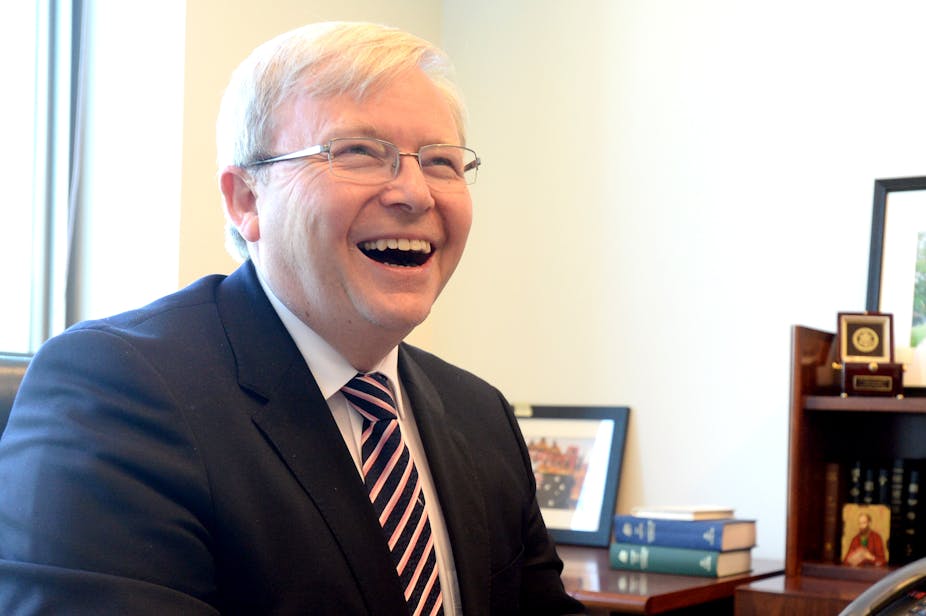Ongoing reflections on the fall of the Rudd/Gillard Labor governments continue to feature suggestions about the impact of policy shifts to the Left, especially under Gillard (possibly influenced by her dalliance with the Greens).
These suggestions mirror those made about the fate of the Whitlam and Howard governments. The increasingly shambolic Leftist reform agenda of the Whitlam years was seen to be too much for the electorate, while the fate of the Howard government was seemingly sealed by shifting too far to the Right in its approach to industrial relations.
This is an intriguing theme, which, as the Whitlam and Howard parallels attest, continues to be raised whenever governments are thrown out rather than nudged out. But discussion rarely approaches the matter from the other direction: what is actually involved in sticking close to the political centre?
For a start, there seems to be little heed paid to the centrist idea that government itself – as it is practised in countries such as Australia – is not only necessary and difficult, it is also laudable. At its very core, this centrist approach to ruling modern countries commits governments to protect those they rule from internal and external threats, so people can enjoy their lives for as long as nature allows. This is the first of four formal criteria of centrist government.
To be able to satisfy the first criterion, a centrist government must establish its sovereignty by achieving three goals. It must: gain and maintain a monopoly on the means of large-scale violence within its territory; win the support of the majority of the people within its territory; and foster an appropriate mix of law and politics.
The second formal criterion is pragmatism. A centrist government must recognise that it will never be able to satisfy the many different goals its people will want it to pursue.
The combination of the first two criteria make centrist rule a tricky business. Centrist governments must not only maintain a procedure for fairly dealing with all goals (which includes managing expectations), but it has to do so without ever faltering in its primary security work. What makes this so difficult is that security is not just about keeping internal and external threats at bay. In fact, it is much broader than that. It also entails keeping the people economically secure, healthy, and well-educated.
In short, while the “safety net” established for these things is quite reasonably called “social security”, a more accurate slogan for the whole of the centrist approach to government would focus more on its capacity to keep its population healthy, wealthy, and wise.
None of this is to suggest, of course, that every centrist government is always successful. The ever-present avalanche of divergent aspirations among the population makes regular failure a certainty. As part of the pragmatism involved, the most that can be hoped for when governments do fail is that they will employ their capacity for trial and error so as not to repeat their mistakes.
The two other formal criteria of centrism are less problematic. They are an aversion to extremes; and a genuine respect for the offices of government.
As discussed earlier, if centrist governments veer too much to the Left or the Right they not only risk losing their centrist identity, but they also risk being kicked out.
The main difficulty here is one of perception. For example, in dealing with the threat of climate change, centrist governments – in line with their commitment to the trinity of health, wealth, and wisdom – have to be able to demonstrate that they are serious about dealing with this threat without diminishing their efforts at fostering economic prosperity, education reform or health reform, among other policy priorities.
Respect for the offices of government is sometimes mistaken as a mark of insincerity. It is not. When Tony Abbott and other senior Coalition figures praised Kevin Rudd upon his retirement from politics, they were displaying respect not just to his contributions but also to the office of prime minister, and to the fact that it is a daunting office to occupy. Centrism involves respect for all the offices of government whether they are held by elected politicians or career public servants.

Centrism also has some informal features to do with the ways in which the voters think about and treat their centrist governments. While committed followers of each side of Australian politics find it difficult to acknowledge the positive contributions of the other side, the Australian electorate as a whole is clearly more flexible (and in being so, more centrist).
Electoral evidence since 1949 – when the two dominant party groupings took their present form (give or take a little tweaking with the rise and fall of the DLP and the shift from Country Party to National Party) – suggests that a majority treats Labor and the Coalition as two ends of the centre, albeit more often implicitly than explicitly.
The main evidence for this claim is not so much that the electorate has rewarded centrism but that it has punished deviations from it. Other evidence includes the electorate’s capacity to ignore party affiliation in finding some figures continuously attractive, such as Malcolm Turnbull.
As a result of this, both sides seem always prepared to work together (eventually) to drive out those minor parties which are considered a common threat. This happened with One Nation and it may well happen with the Greens, though they appear to have a stronger base.
In all of this, the Australian electorate seems to be saying that since 1949 it thinks centrist governments have done a reasonably good job in the healthy-wealthy-wise stakes. This is probably grudging praise, along the lines of Winston Churchill’s famous 1947 quip that:
Democracy is the worst form of government, except for all those other forms that have been tried from time to time.
And yet, it is still praise.

